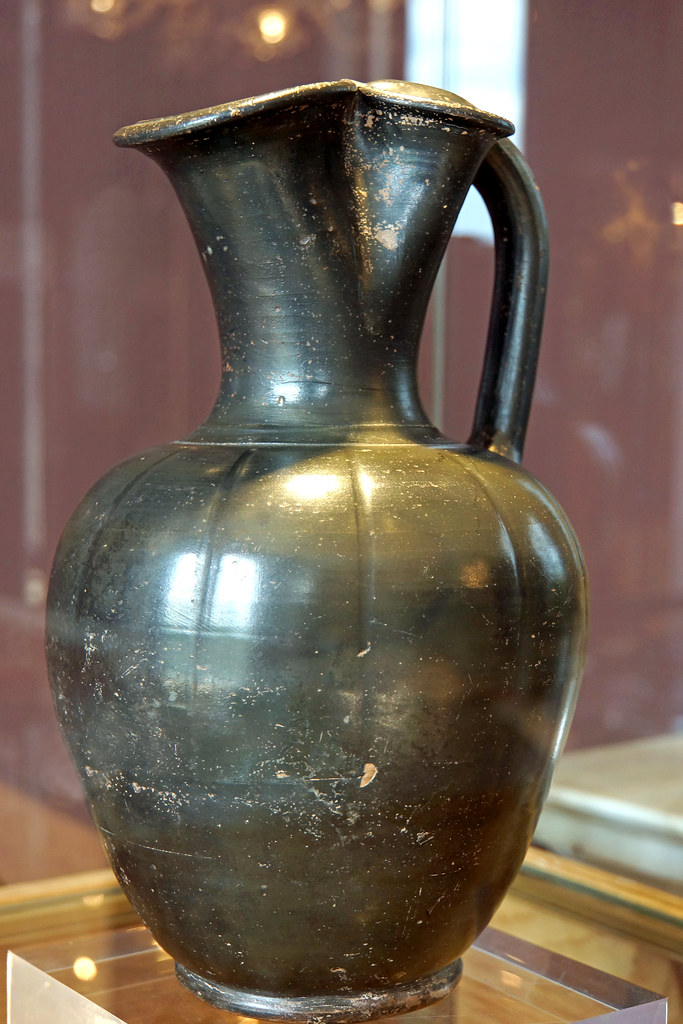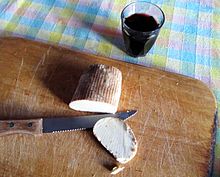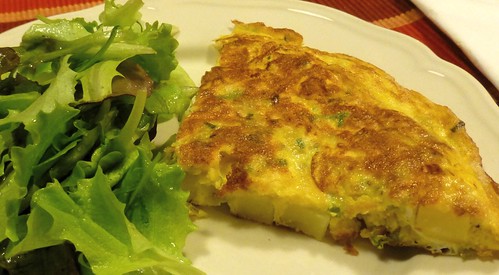 When
they arrive at the Assyrian camp, Judith demands to see Holofernes.
She's realized the city is doomed, she says, and has come to him for
protection. Struck by her beauty, Holofernes invites her into his tent,
where she regales him with the supplies she's brought. The salty cheese
makes him thirsty, so he drinks too much wine. Soon, he falls into a
deep sleep. Judith prays to God for strength, takes Holofernes' sword,
and decapitates him. Then she wraps his head in a cloth, and she and her
maid sneak out of the camp and return to Bethulia.
When
they arrive at the Assyrian camp, Judith demands to see Holofernes.
She's realized the city is doomed, she says, and has come to him for
protection. Struck by her beauty, Holofernes invites her into his tent,
where she regales him with the supplies she's brought. The salty cheese
makes him thirsty, so he drinks too much wine. Soon, he falls into a
deep sleep. Judith prays to God for strength, takes Holofernes' sword,
and decapitates him. Then she wraps his head in a cloth, and she and her
maid sneak out of the camp and return to Bethulia.The story of Judith doesn't fit most traditional definitions of "mystery." It does contain elements suitable for a thriller--a brutal and lustful villain, a beautiful woman with a daring scheme, the fates of nations at stake. And someone gets killed--almost always a plus, in either a mystery or a thriller. There's no doubt about whodunit, though, or how she done it, or why she done it. Even so, mystery surrounds the story. What are its origins? Is it history or fiction? In what ways, if any, is it linked to Hanukkah--and even to Hanukkah foods? We'll get to all that. But let's start with the story itself. It's a good one.

It goes back over two thousand years. There are several versions, some long and elaborate--the one in the Catholic bible, for example, is divided into sixteen chapters packed with details. I'll stick to basics, emphasizing elements that could connect the story to Hanukkah.
In ancient Israel, evil Assyrian general Holofernes attacks the city of Bethulia. The inhabitants fight back and manage to keep him from taking the city, but they're too badly outnumbered to defeat him outright. Frustrated by the stalemate, Holofernes decides to starve the Jews into submission. He lays siege to the city.
As supplies of food and water dwindle, Bethulia's elders and military leaders begin to talk of surrender. Judith, a beautiful and virtuous young widow, steps forward to rebuke them. God will save the city, she says. Further, He will deliver Holofernes into the hands of a woman. She puts on the fine clothes she hasn't worn since her husband's death, packs a bag with cheese and old wine, and leaves the city, accompanied only by her maid.
 | ||||
Judith with the Head of Holophernes,
by Cristofano Allori, 1613
(Royal Collection, London)
|
That's the story. Now comes the mystery. Is the story of Judith based on a real event that took place during the Maccabee revolt? Opinions vary. The oldest existing text of the story is written in Greek. People who know much more about such things than I do think it's probably a translation of an earlier, lost Hebrew text written around 150 B.C.E.--not long after the Maccabee revolt against Assyrian/Greek oppression. But the Greek text makes no reference to the Maccabee revolt, and it has some odd, confusing features. For example, it says Holofernes served Nebuchadnezzar, not the evil King Antiochus of the Hanukkah story. To muddy the waters further, it identifies Nebuchadnezzar as "a king of Assyria," not of Babylon. And there's little historical evidence to confirm the existence of a city called Bethulia. In Hebrew, Bethulia means "a virgin." Some see it as a poetic way of referring to Jerusalem, and some think it's a symbolic reference to Judith's chastity. Some, on the other hand, say it's an indication that the Book of Judith is a work of fiction.
 In some ways, the book does seem like a fanciful reweaving of the stories of several heroic women in the Jewish bible (or the Tanakh--a
Hebrew acronym for Torah, Prophets, and Writings, essentially the same
as the Protestant Old Testament except that we put the books in a
different order). First there's Deborah, the judge and prophet, who
urges a general, Barak, to resist the oppression of the king of Canaan
and his general, Sisera. Barak falters, saying he won't lead the army
into battle unless Deborah accompanies him. Deborah agrees but says the
glory of victory will therefore belong to a woman. Inspired by Deborah,
the Jews defeat Sisera, who flees the battle. That's when another heroic
woman, Yael (or Jael)--a Kenite, not a Jew--takes over. Seeking refuge,
Sisera comes to Yael's tent and asks for water. She gives him milk, he
falls asleep, and she kills him by driving a tent stake through his
head. Finally, there's Esther. a Jewish girl who becomes queen of
Persia. She's the heroine of the biblical book of Esther and also of the
Jewish holiday of Purim. When wicked Haman schemes to kill all the Jews
of Persia, Esther steps forward and risks her life to stop him, and the
Jews of Persia are saved. It's hard to miss the parallels between these
three stories and the story of Judith.
In some ways, the book does seem like a fanciful reweaving of the stories of several heroic women in the Jewish bible (or the Tanakh--a
Hebrew acronym for Torah, Prophets, and Writings, essentially the same
as the Protestant Old Testament except that we put the books in a
different order). First there's Deborah, the judge and prophet, who
urges a general, Barak, to resist the oppression of the king of Canaan
and his general, Sisera. Barak falters, saying he won't lead the army
into battle unless Deborah accompanies him. Deborah agrees but says the
glory of victory will therefore belong to a woman. Inspired by Deborah,
the Jews defeat Sisera, who flees the battle. That's when another heroic
woman, Yael (or Jael)--a Kenite, not a Jew--takes over. Seeking refuge,
Sisera comes to Yael's tent and asks for water. She gives him milk, he
falls asleep, and she kills him by driving a tent stake through his
head. Finally, there's Esther. a Jewish girl who becomes queen of
Persia. She's the heroine of the biblical book of Esther and also of the
Jewish holiday of Purim. When wicked Haman schemes to kill all the Jews
of Persia, Esther steps forward and risks her life to stop him, and the
Jews of Persia are saved. It's hard to miss the parallels between these
three stories and the story of Judith.But while Deborah, Yael, and Esther all made it into the Jewish and Protestant bibles, Judith did not. The Catholic bible includes the Book of Judith, but the Protestant bible relegates it to the apocrypha, and the Jewish bible doesn't grant it any canonical status at all, maybe because its basis in fact seems so shaky. Jews loved Judith's story, however, and a number of prominent Jewish rabbis and commentators mention it in their writings, saying Judith deserves everlasting praise. Jewish retellings of the story often emphasize (or invent) links with Hanukkah. Some versions of the story say Judith was the sister of Judah Maccabee, the hero of the Hanukkah revolt against the Greek/Assyrian empire. (Judith and Judah--they could be twins.) And medieval Jewish retellings add the detail about Judith feeding Holofernes cheese in order to make him thirsty, drunk, and vulnerable. Many authorities say that's the origin of the tradition of eating cheese on Hanukkah.
 In
fact, the first latkes were probably cheese pancakes, not potato
pancakes. After all, the potato wasn't introduced to Europe until a mere
four hundred or so years ago. Long before that, Sephardic Jews
evidently celebrated Hanukkah with latkes made of ricotta and other
cheeses--always fried in oil, to commemorate the Hanukkah miracle that
took place when the temple in Jerusalem was recaptured and rededicated
by the triumphant Maccabees. They found only a tiny bit of pure oil,
enough to keep the Eternal Light burning for just one day--but it lasted
for eight days, until more pure oil could be prepared. (The other day, I
came across a Food Network recipe for latkes fried not in oil but in
clarified butter. Oy vey. What's the point?)
In
fact, the first latkes were probably cheese pancakes, not potato
pancakes. After all, the potato wasn't introduced to Europe until a mere
four hundred or so years ago. Long before that, Sephardic Jews
evidently celebrated Hanukkah with latkes made of ricotta and other
cheeses--always fried in oil, to commemorate the Hanukkah miracle that
took place when the temple in Jerusalem was recaptured and rededicated
by the triumphant Maccabees. They found only a tiny bit of pure oil,
enough to keep the Eternal Light burning for just one day--but it lasted
for eight days, until more pure oil could be prepared. (The other day, I
came across a Food Network recipe for latkes fried not in oil but in
clarified butter. Oy vey. What's the point?) Today,
potato latkes are definitely the latkes of choice for most Jews, though
there are plenty of variations on the basic recipe, some using sweet
potatoes, some incorporating other vegetables such as carrots or
zucchini. My favorite latke recipe was included in "Death on the List," a
Hanukkah whodunit published in Alfred Hitchcock's Mystery Magazine back in 1999. The recipe's available on my website-http://www.bkstevensmysteries.com/recipes-from-the-stories/-
Today,
potato latkes are definitely the latkes of choice for most Jews, though
there are plenty of variations on the basic recipe, some using sweet
potatoes, some incorporating other vegetables such as carrots or
zucchini. My favorite latke recipe was included in "Death on the List," a
Hanukkah whodunit published in Alfred Hitchcock's Mystery Magazine back in 1999. The recipe's available on my website-http://www.bkstevensmysteries.com/recipes-from-the-stories/- But, like many Jews, my family always eats cheese on Hanukkah, too--cheese blintzes, cheese pie, even grilled cheese sandwiches. This year, for the first night of Hanukkah, my husband and I had, as usual, potato latkes and a Sephardic cheese frittata. The recipe for the fritatta follows. It's simple, it's delicious, and it's baked in oil. And if the cheese makes you thirsty and you have an extra glass of wine, so what? As long as you're among friends, you should be fine. If you decide to give the recipe a try, think of Judith when you sit down to dinner. Maybe she was an actual person, and maybe she wasn't. Maybe she had something to do with Hanukkah, and maybe she didn't. Her story will probably always be wrapped in mystery. Even so, like other mystery heroines, she can inspire us with her cleverness, and with her courage.

Bernice's Cheese Frittata
(Sephardic Style Cheese Souffle)
2 cups milk
1 cup flour
1 teaspoon salt
grated cheese--about 2 cups
spices such as pepper, tarragon, and nutmeg (optional)
1/4 cup vegetable oil
grated Parmesan cheese (optional)
- Mix all ingredients, except oil and Parmesan, until slightly frothy.
- Preheat oven to 400 degrees. Spread oil evenly in 9 x 13" baking pan; heat in oven.
- When oil is frying hot, approximately 2--3 minutes, pour batter into pan. If desired, sprinkle with Parmesan.
- Bake approximately half an hour at 400 degrees, until a butter knife inserted in the fritatta comes out nearly clean.
- Any type of cooking cheese should work. Bernice's favorite combination is grated Muenster and Romano. We also like using 1 cup cheddar, 1/2 cup fontina, and 1/2 cup Gruyere.
- Serves four to six (depending on how hungry they are, and how many latkes they're having as a side dish)

First night of Hanukkah, 2015: Three unusually adorable grandchildren, many menorahs in the window